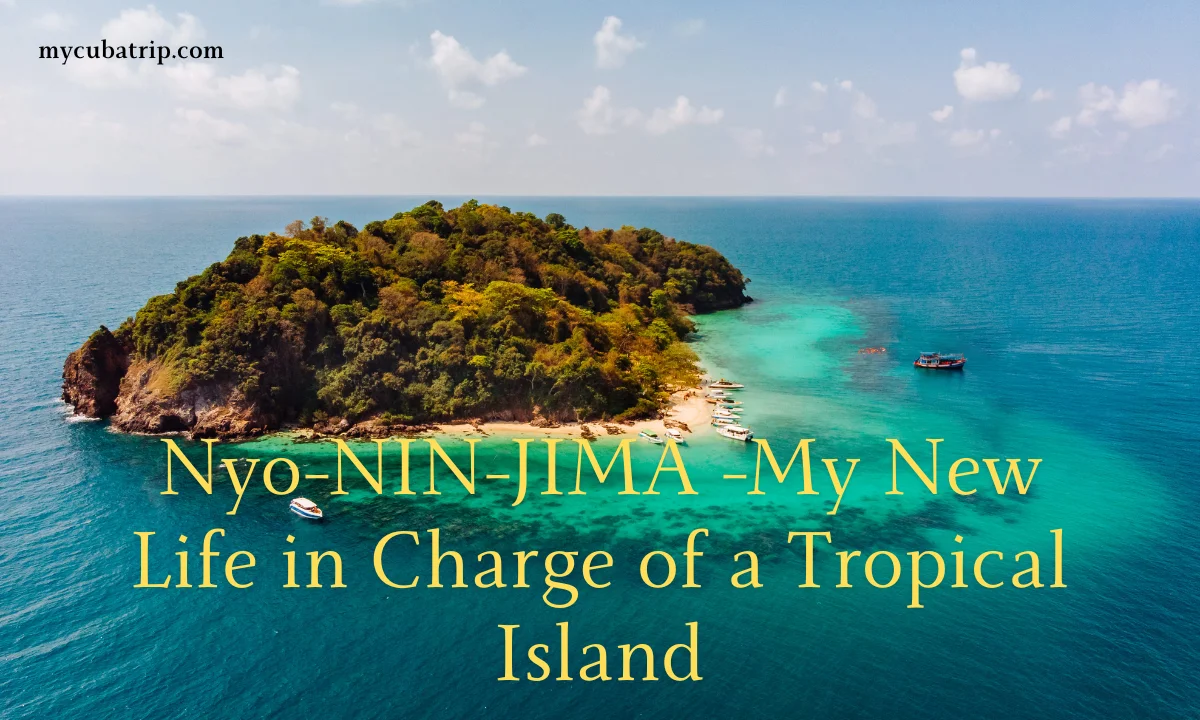Nyo-NIN-JIMA -My New Life in Charge of a Tropical Island, known for its serene beauty and historical significance. Often overshadowed by its more famous neighbor, Iwo Jima, Nyo-nin-jima offers a unique opportunity for exploration and discovery. This article delves into the experiences and challenges of living on this remote island, providing an insightful look into what it means to manage such a pristine piece of paradise.
A Glimpse of Nyo-NIN-JIMA -My New Life in Charge of a Tropical Island History
Nyo-nin-jima, like Iwo Jima, has a rich and complex history. While Iwo Jima is widely known for its role in World War II, Nyo-nin-jima’s history is more subtle, often associated with Japanese cultural traditions and its strategic location. The island’s history is steeped in tales of wartime strategy and peacetime tranquility, making it a fascinating subject for history enthusiasts.
Life on the Island: A Day in the Life
Life on the Island, Living on Nyo-NIN-JIMA -My New Life in Charge of a Tropical Island is an experience like no other. The island, characterized by its lush tropical landscape, offers a peaceful retreat from the hustle and bustle of mainland life. The responsibilities of managing the island include maintaining its natural beauty, overseeing conservation efforts, and ensuring the well-being of the few inhabitants and visitors.
Daily Activities:
- Morning Routine: Start the day early with a walk along the pristine beaches.
- Maintenance: Check and maintain the island’s infrastructure, including paths and buildings.
- Conservation Efforts: Work with local authorities to protect the island’s flora and fauna.
- Visitor Management: Welcome and guide tourists, ensuring they respect the island’s natural environment.
Challenges and Rewards of Island Management
Nyo-NIN-JIMA -My New Life in Charge of a Tropical Island: Managing Nyo-nin-jima comes with its own set of challenges and rewards. The isolation can be both a blessing and a curse, offering tranquility but also requiring careful planning and resource management.
Challenges:
- Limited Resources: Access to fresh water and supplies is limited, requiring careful rationing.
- Communication: Maintaining contact with the mainland can be difficult, especially during bad weather.
- Conservation: Balancing the island’s natural preservation with visitor activities is crucial.
Rewards:
- Natural Beauty: The island’s untouched landscapes offer breathtaking views and peaceful surroundings.
- Cultural Significance: The opportunity to be part of preserving a piece of Japanese heritage is a unique honor.
- Community: Building a close-knit community with the island’s residents and visitors is a rewarding experience.
Exploring Nyo-NIN-JIMA -My New Life in Charge of a Tropical Island: Attractions and Activities
Nyo-NIN-JIMA -My New Life in Charge of a Tropical Island: For visitors, Nyo-nin-jima offers a range of activities and attractions. From exploring historical sites to engaging in outdoor adventures, the island caters to various interests.
Top Attractions:
- Historical Sites: Explore remnants of past conflicts and understand the island’s strategic importance.
- Natural Wonders: Enjoy the island’s diverse ecosystems, from lush forests to vibrant coral reefs.
- Outdoor Activities: Engage in hiking, snorkeling, and wildlife watching.
Activities:
- Snorkeling: Discover the underwater beauty of the island’s coral reefs.
- Hiking: Traverse the island’s scenic trails and enjoy panoramic views.
- Wildlife Watching: Observe the unique flora and fauna that call the island home.
A Sustainable Future for Nyo-nin-jima
Nyo-NIN-JIMA -My New Life in Charge of a Tropical Island: The future of Nyo-nin-jima depends heavily on sustainable practices. Efforts to preserve the island’s natural resources and cultural heritage are crucial for ensuring it remains a pristine and welcoming destination.
Sustainability Initiatives:
- Conservation Programs: Implementing programs to protect the island’s unique ecosystems.
- Renewable Energy: Exploring options for sustainable energy sources to reduce the island’s carbon footprint.
- Eco-tourism: Promoting responsible tourism that respects the environment and local culture.
Living the Island Life: Personal Reflections

Living on Nyo-NIN-JIMA -My New Life in Charge of a Tropical Island is a transformative experience. The opportunity to connect with nature and live a simpler life is a stark contrast to the fast-paced lifestyle of the mainland. The island offers a chance to slow down, appreciate the beauty of the natural world, and reflect on the importance of conservation and sustainability.
Personal Highlights:
- Nature’s Beauty: The daily experience of witnessing stunning sunrises and sunsets.
- Community Spirit: Building relationships with a diverse group of people who share a love for the island.
- Sense of Purpose: The fulfillment of contributing to the preservation of a unique and beautiful place.
The Unique Flora and Fauna of Nyo-nin-jima
Nyo-NIN-JIMA -My New Life in Charge of a Tropical Island boasts a rich diversity of flora and fauna. The island’s tropical climate supports a wide range of plant species, from lush palm trees to vibrant tropical flowers. The surrounding waters are teeming with marine life, including colorful coral reefs and various fish species. This biodiversity makes the island a haven for nature lovers and biologists alike.
The Cultural Significance of Nyo-nin-jima
Nyo-NIN-JIMA -My New Life in Charge of a Tropical Island holds a special place in Japanese culture and history. The island’s strategic location has made it a site of interest throughout the centuries, particularly during wartime. Unlike its more famous neighbor, Iwo Jima, Nyo-nin-jima has remained relatively peaceful, serving as a symbol of serenity amidst the tumultuous events of history.
Local legends and folklore enrich the cultural landscape of Nyo-nin-jima. These stories often revolve around the island’s natural features and historical events, adding a layer of mystique and cultural depth. The island is also associated with traditional Japanese practices, such as Shinto rituals, reflecting the spiritual connection between the land and its people.
Visitors to Nyo-nin-jima often find themselves immersed in its unique cultural atmosphere. The island offers a glimpse into a slower, more traditional way of life, contrasting sharply with the rapid pace of modern Japan. This cultural immersion is a significant draw for those interested in understanding the diverse aspects of Japanese heritage.
Future Prospects and Vision for Nyo-NIN-JIMA -My New Life in Charge of a Tropical Island
The future of Nyo-NIN-JIMA -My New Life in Charge of a Tropical Island is focused on sustainable development and conservation. As the island continues to attract interest, there are plans to expand eco-tourism while preserving its natural beauty. This includes creating guided tours that highlight the island’s unique flora, fauna, and cultural heritage, all while ensuring minimal environmental impact.
Another key aspect of the vision for Nyo-in-Jima is enhancing conservation efforts. This involves protecting endangered species, restoring native vegetation, and implementing measures to combat the effects of climate change. By focusing on sustainability, the island aims to serve as a model for environmental stewardship.
Conservation Efforts and Challenges
Nyo-NIN-JIMA -My New Life in Charge of a Tropical Island faces several conservation challenges, primarily due to its isolated location and fragile ecosystems. The island’s unique flora and fauna are vulnerable to threats such as invasive species, climate change, and human activity. To address these issues, a variety of conservation efforts are underway.
One of the primary conservation initiatives on Nyo-NIN-JIMA -My New Life in Charge of a Tropical Island is the protection of endangered species. This involves monitoring local wildlife populations and implementing measures to safeguard their habitats. Efforts include controlling invasive plant species that threaten native vegetation and restoring areas that have been damaged by past activities.
The Role of Technology in Island Management
Technology plays a crucial role in managing Nyo-nin-jima. From renewable energy solutions like solar panels to satellite communication systems, technology helps overcome the challenges of island living. These innovations make it easier to manage resources, monitor environmental changes, and stay connected with the mainland. They are essential tools for ensuring the island’s sustainability and improving the quality of life for its residents.
FAQ: Nyo-NIN-JIMA -My New Life in Charge of a Tropical Island
What is the best time to visit Nyo-nin-jima?
The best time to visit is during the dry season, from November to April when the weather is pleasant.
How can I reach Nyo-nin-jima?
Access is typically via a boat or helicopter from nearby islands or the mainland.
Is there accommodation available on the island?
Limited accommodation is available, primarily for researchers and conservationists.
What wildlife can be found on Nyo-nin-jima?
The island is home to various bird species, reptiles, and marine life.
Are there any specific rules for visitors?
Visitors are encouraged to respect the natural environment and follow guidelines to minimize their impact.
Conclusion
Nyo-nin-jima offers a unique blend of natural beauty, historical significance, and a tranquil lifestyle. Managing the island is both a privilege and a responsibility, requiring a commitment to conservation and sustainability. As interest in this tropical paradise grows, it is essential to balance tourism with the preservation of its unique ecosystems and cultural heritage.

